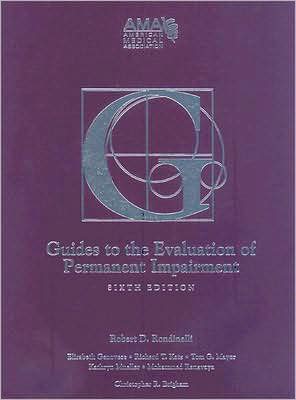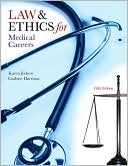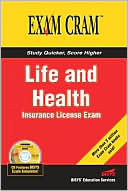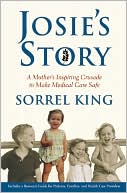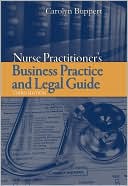Guides to the Evaluation of Permanent Impairment
This reference for clinicians describes criteria for the assessment and rating of an individual's permanent impairment in the United States. Introductory chapters discuss such topics as impairment evaluation in Workers' Compensation cases and the physician's role based on the Americans with Disabilities Act. The main part of the text consists of individual chapters devoted to various systems of the body. Each of these chapters includes an overview of impairment assessment for that body...
Search in google:
This reference for clinicians describes criteria for the assessment and rating of an individual's permanent impairment in the United States. Introductory chapters discuss such topics as impairment evaluation in Workers' Compensation cases and the physician's role based on the Americans with Disabilities Act. The main part of the text consists of individual chapters devoted to various systems of the body. Each of these chapters includes an overview of impairment assessment for that body system; a description and interpretation of common signs and symptoms of disorders; a summary of common investigative clinical procedures; case studies; and clinical criteria used to determine impairment ratings. Annotation c. Book News, Inc., Portland, OR (booknews.com) Doody Review Services Reviewer:J. Thomas Pierce, MBBS PhD(Navy Environmental Health Center)Description:The Guides defines a new standard for impairment assessment, applying the International Classification of Functionality (ICF) in order to make the impairment ratings more relevant and to promote greater precision for this process. Assisting Dr. Rondinelli are 10 senior editors, 3 contributing editors, a 20-person advisory committee, and roughly 50 chapter authors, along with 100 reviewers across three continents. By my count, chapters typically include case examples of conditions (typically stretching from class 0 to class 3 -4), at least a half dozen illustrations, and 5-20 tables. Purpose:The first page fairly describes the history, if not the purpose of this book: "Tolerance of and care for the sick and the disabled (are) elemental components of our social fabric, rooted in the origins of human society." Chapter 2 notes that the book is "written by medical doctors for other medical doctors as a tool to translate human pathology resulting from a trauma or disease process into a percentage of the whole person." The inclusion of ICF terminology and definitions requires careful reading beyond just looking up conditions and determining an impairment class. Audience:While the primary users of this book may be fairly narrowly defined as physicians involved in the rating process, a much broader range of individuals will likely read it, if not use it. From the standpoint of clinical anatomy, this book provides an excellent review of nearly everything one (hopefully) learned in medical school. It would be naive not to believe this book will acquire readership in the insurance, loss prevention, and legal communities. In fairness, it should also be noted that the members of the disabled community have been principal advocates and pathfinders for the entire ICF movement. Features:A key overarching principle of this book is that evaluations should address complementary scales of human usable capacity in the setting of performance qualifiers. I found it advisable to spend a lot of time rereading the conceptual foundations before looking at other chapters. Chapters could be termed suites: introductory (3); systemic (6); sensorineural (3); dermal (1); ear, nose, and throat (1); and orthopedic (3). The orthopedic contributors tend to use more illustrations and tables while some of the systemic chapter authors are more reliant on words. Assessment:Evaluators might liken the contribution made by this book to Churchill's observation regarding democracy. ("Indeed, it has been said that democracy is the worst form of Government except all those other forms that have been tried from time to time." (.-Winston S. Churchill: His Complete Speeches, 1897-1963, ed. Robert Rhodes James, vol. 7, p. 7566 (1974).) I would like to compliment the editors on addressing tough questions and remaining fair. Given its reorientation in terms of ICF, the Guides' treatment of permanent impairment incorporates consensus opinions from the World Health Organization and the Institute of Medicine. In an era of increasingly sophisticated means of revisionist surgery and regenerative therapeutics, new means of evaluating permanency must be used. The seminal paper of Saad Nagi (1969) allowed subsequent development of the ICF concept, but it will be publications such as this that can truly operationalize its meaning.
Chapter 1Philosophy, Purpose, and Appropriate Use of the Guides11.1History11.2Impairment, Disability, and Handicap21.3The Organ System and Whole Body Approach to Impairment91.4Philosophy and Use of the Combined Values Chart91.5Incorporating Science With Clinical Judgment101.6Causation, Apportionment Analysis, and Aggravation111.7Use of the Guides121.8Impairment Evaluations in Workers' Compensation131.9Employability Determinations131.10Railroad and Maritime Workers141.11The Physician's Role Based on the Americans with Disabilities Act (ADA)141.12Summary15Chapter 2Practical Application of the Guides172.1Defining Impairment Evaluations182.2Who Performs Impairment Evaluations?182.3Examiners' Roles and Responsibilities182.4When Are Impairment Ratings Performed?192.5Rules for Evaluation192.6Preparing Reports21Chapter 3The Cardiovascular System: Heart and Aorta253.1Principles of Assessment263.2Vavular Heart Disease293.3Coronary Heart Disease353.4Congenital Heart Disease423.5Cardiomyopathies473.6Pericardial Heart Disease523.7Arrhythmias563.8Cardiovascular Impairment Evaluation Summary60Chapter 4The Cardiovascular System: Systemic and Pulmonary Arteries654.1Hypertensive Cardiovascular Disease664.2Disease of the Aorta704.3Vascular Diseases Affecting the Extremities734.4Diseases of the Pulmonary Arteries794.5Cardiovascular Impairment Evaluation Summary82Chapter 5The Respiratory System875.1Principles of Assessment885.2Symptoms Associated With Respiratory Disease895.3Tobacco Use and Environment Exposure Associated With Respiratory Disease905.4Examinations, Clinical Studies, and Other Tests for Evaluating Respiratory Disease915.5Asthma1025.6Obstructive Sleep Apnea1055.7Hypersensitivity Pneumonitis1055.8Penumoconiosis1065.9Lung Cancer1065.10Permanent Impairment Due to Respiratory Disorders1075.11Respiratory Impairment Evaluation Summary112Chapter 6The Digestive System1176.1Principles of Assessment1186.2Upper Digestive Tract1206.3Colon, Rectum, and Anus1286.4Enterocutaneous Fistulas1326.5Liver and Biliary Tract1336.6Hernias1366.7Digestive System Impairment Evaluation Summary138Chapter 7The Urinary and Reproductive Systems1437.1Principles of Assessment1447.2The Urinary System1447.3Upper Urinary Tract1457.4Urinary Diversion1507.5Bladder1517.6Urethra1537.7Male Reproductive Organs1577.8Female Reproductive Organs1637.9Urinary and Reproductive Systems Impairment Evaluation Summary170Chapter 8The Skin1738.1Principles of Assessment1748.2Disfigurement1758.3Scars and Skin Grafts1768.4Contact Dermatitis1768.5Natural Rubber Latex Allergy1778.6Skin Cancer1778.7Criteria for Rating Permanent Impairment Due to Skin Disorders1788.8Skin Impairment Evaluation Summary188Chapter 9The Hematopoietic System1919.1Principles of Assessment1929.2Anemia1929.3Polycythemia and Myelofibrosis1969.4White Blood Cell Disease or Abnormalities1979.5Hemorrhagic and Platelet Disorders2039.6Thrombotic Disorders2069.7Hematologic Impairment Evaluation Summary208Chapter 10The Endocrine System21110.1Principles of Assessment21210.2Hypothalamic. Pituitary Axis21210.3Thyroid21710.4Parathyroids21910.5Adrenal Cortex22210.6Adrenal Medulla22810.7Pancreas (Islets of Langerhans)23010.8Gonads23710.9Mammary Glands23910.10Metabolic Bone Disease24010.11Endocrine System Impairment Evaluation Summary241Chapter 11Ear, Nose, Throat, and Related Structures24511.1Principles of Assessment24611.2The Ear24611.3The Face25511.4The Nose, Throat, and Related Structures25911.5Ear, Nose, Throat, and Related Structures Impairment Evaluation Summary272Chapter 12The Visual System27712.1Principles of Assessment27812.2Impairment of Visual Acuity28112.3Impairment of the Visual Field28712.4Impairment of the Visual System29612.5Visual Acuity Measurement at Near (Reading Acuity)300Chapter 13The Central and Peripheral Nervous System30513.1Principles of Assessment30513.2Criteria for Rating Impairment Due to Central Nervous System Disorders30813.3Criteria for Rating Cerebral Impairments30913.4Criteria for Rating Impairments of the Cranial Nerves32713.5Criteria for Rating Impairments of Station, Gait, and Movement Disorders33613.6Criteria for Rating Impairments of Upper Extremities Related to Central Impairment33813.7Criteria for Rating Spinal Cord and Related Impairments34013.8Criteria for Rating Impairments Related to Chronic Pain34313.9Criteria for Rating Impairments of the Peripheral Nervous System, Neuromuscular Junction, and Muscular System34413.10Nervous System Impairment Evaluation Summary352Chapter 14Mental and Behavioral Disorders35714.1Principles of Assessment35814.2Psychiatric Diagnosis and Impairment35914.3A Method of Evaluating Psychiatric Impairment36114.4Assessing Impairment Severity36414.5Examples of Impairment Due to Mental and Behavioral Disorders36714.6Format of the Impairment Report370Chapter 15The Spine37315.1Principles of Assessment37415.2Determining the Appropriate Method for Assessment37915.3Diagnosis-Related Estimates Method38115.4DRE: Lumbar Spine38415.5DRE: Thoracic Spine38815.6DRE: Cervical Spine39215.7Rating Corticospinal Tract Damage39515.8Range-of-Motion Method39815.9ROM: Lumbar Spine40515.10ROM: Thoracic Spine41115.11ROM: Cervical Spine41715.12Nerve Root and/or Spinal Cord42315.13Criteria for Converting Whole Person Impairment to Regional Spine Impairment42715.14The Pelvis42715.15Spine Evaluation Summary429Chapter 16The Upper Extremities43316.1Principles of Assessment43416.2Amputations44116.3Sensory Impairment Due to Digital Nerve Lesions44516.4Evaluating Abnormal Motion45016.5Impairment of the Upper Extremities Due to Peripheral Nerve Disorders48016.6Impairment of the Upper Extremities Due to Vascular Disorders49716.7Impairment of the Upper Extremities Due to Other Disorders49816.8Strength Evaluation50716.9Summary of Steps for Evaluating Impairments of the Upper Extremity51116.10Clinical Examples512Chapter 17The Lower Extremities52317.1Principles of Assessment52417.2Methods of Assessment52517.3Lower Extremity Impairment Evaluation Procedure Summary and Examples555Chapter 18Pain56518.1Principles of Assessment56618.2Overview of Pain56618.3Integrating Pain-Related Impairment Into the Conventional Impairment Rating System56918.4Behavioral Confounders58118.5How to Rate Pain-Related Impairment: A Sample Protocol58318.6Psychogenic Pain58518.7Malingering58518.8Conclusion58618.9Case Examples586AppendixRecording Range-of-Motion Measurements593Glossary599Combined Values Chart604Index607
\ From The CriticsReviewer: J. Thomas Pierce, MBBS PhD(Navy Environmental Health Center)\ Description: The Guides defines a new standard for impairment assessment, applying the International Classification of Functionality (ICF) in order to make the impairment ratings more relevant and to promote greater precision for this process. Assisting Dr. Rondinelli are 10 senior editors, 3 contributing editors, a 20-person advisory committee, and roughly 50 chapter authors, along with 100 reviewers across three continents. By my count, chapters typically include case examples of conditions (typically stretching from class 0 to class 3 -4), at least a half dozen illustrations, and 5-20 tables. \ Purpose: The first page fairly describes the history, if not the purpose of this book: "Tolerance of and care for the sick and the disabled (are) elemental components of our social fabric, rooted in the origins of human society." Chapter 2 notes that the book is "written by medical doctors for other medical doctors as a tool to translate human pathology resulting from a trauma or disease process into a percentage of the whole person." The inclusion of ICF terminology and definitions requires careful reading beyond just looking up conditions and determining an impairment class. \ Audience: While the primary users of this book may be fairly narrowly defined as physicians involved in the rating process, a much broader range of individuals will likely read it, if not use it. From the standpoint of clinical anatomy, this book provides an excellent review of nearly everything one (hopefully) learned in medical school. It would be naive not to believe this book will acquire readership in the insurance, loss prevention, and legal communities. In fairness, it should also be noted that the members of the disabled community have been principal advocates and pathfinders for the entire ICF movement. \ Features: A key overarching principle of this book is that evaluations should address complementary scales of human usable capacity in the setting of performance qualifiers. I found it advisable to spend a lot of time rereading the conceptual foundations before looking at other chapters. Chapters could be termed suites: introductory (3); systemic (6); sensorineural (3); dermal (1); ear, nose, and throat (1); and orthopedic (3). The orthopedic contributors tend to use more illustrations and tables while some of the systemic chapter authors are more reliant on words. \ Assessment: Evaluators might liken the contribution made by this book to Churchill's observation regarding democracy. ("Indeed, it has been said that democracy is the worst form of Government except all those other forms that have been tried from time to time." (.-Winston S. Churchill: His Complete Speeches, 1897-1963, ed. Robert Rhodes James, vol. 7, p. 7566 (1974).) I would like to compliment the editors on addressing tough questions and remaining fair. Given its reorientation in terms of ICF, the Guides' treatment of permanent impairment incorporates consensus opinions from the World Health Organization and the Institute of Medicine. In an era of increasingly sophisticated means of revisionist surgery and regenerative therapeutics, new means of evaluating permanency must be used. The seminal paper of Saad Nagi (1969) allowed subsequent development of the ICF concept, but it will be publications such as this that can truly operationalize its meaning.\ \ \ 3 Stars from Doody\ \
